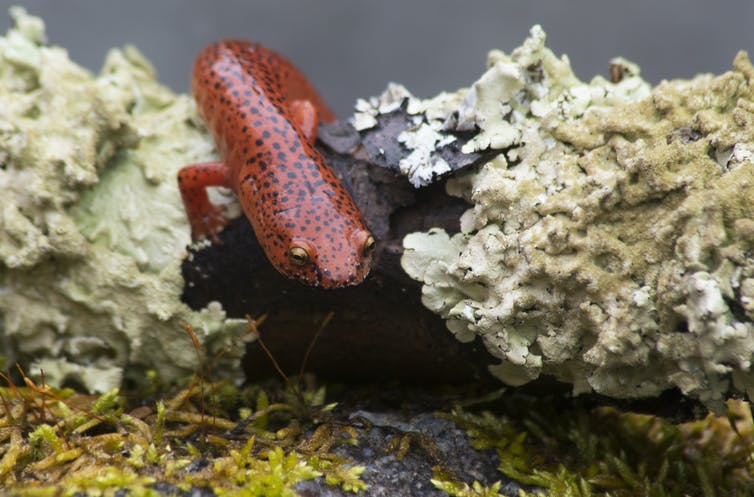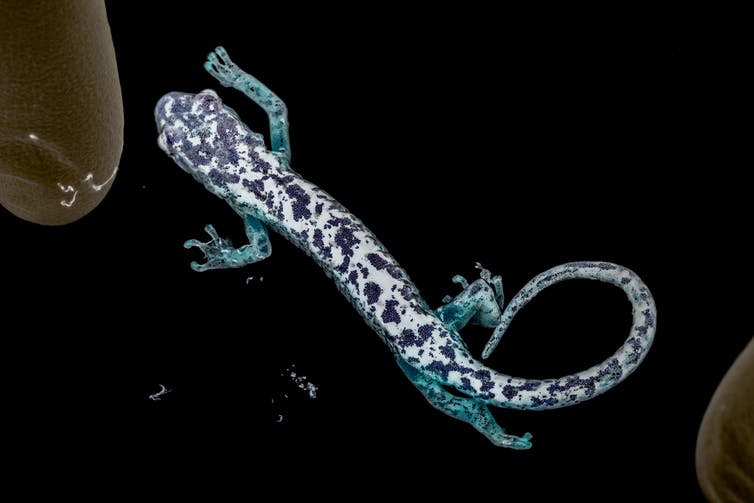The Southern Appalachian mountains are a global biodiversity hot spot for salamanders. Dr. Deb Miller and Dr. Matt Gray lead the Amphibian Disease Laboratory at the University of Tennessee and are looking at various strategies to prevent a fungus that is deadly to salamanders from entering the U.S. via the international pet trade. They are also conducting research to learn more about the disease, and looking at potential strategies to reduce the spread of the fungus in case it does enter the country._
Why do the Appalachian mountains have so many salamanders?
The intersection of North Carolina, Tennessee and Georgia is a global biodiversity hot spot for salamanders. Tennessee, for example, has around 60 species, more than the entire continent of Europe.
The southern Appalachian Mountain Range is one of the oldest mountain ranges in the world, so there has been a lot of opportunity for many species to evolve over a long period of time. The temperate conditions and high elevations create a forest system with lots of moisture and accumulated leaf litter. Over time, that creates the perfect habitat for salamanders.
What is the fungus that threatens the salamanders?
Batrachochytrium salamandrivorans, or Bsal, is the second chytrid fungus that has been discovered. The first chytrid fungus that many people have heard about is called Batrachochytrium dendrobatidis, or Bd, and that’s been associated with the decline of over 500 amphibian species globally and over 100 species extinctions.
Bsal fungus specifically attacks the outer covering of a salamander’s skin, but we are finding that it can attack frog skin as well. The skin is one of the most important organs in an amphibian’s body. It is so important because some salamanders don’t have lungs, and so the skin is a major source for respiration for them. It also maintains the right amount of hydration so that their body systems, including their heart, can function properly.
The name salamandrivorans literally means that it eats the salamander. In actuality, it destroys the skin with a coating of fungus. The skin stops functioning, and the animal shuts down and dies.
Todd Amacker, CC BY-NC-ND
The fungus hasn’t yet entered North America, but what was its effect on amphibians in Europe?
The discovery of a new chytrid fungus in Northern Europe was very alarming. It was discovered in 2010, and since then, salamander populations all over Europe have seen precipitous declines. There’s now research that indicates that it may have actually been introduced around Germany and spread out from there.
It has been found in Southeast Asia infecting salamanders but having no effects on them. It seems to live with the salamanders there. But it is believed to have been introduced to Europe through the international pet trade. We have not detected Bsal yet here in North America, or any place in the Western Hemisphere, but we are concerned that the pet trade is the most likely route for introduction here.
What are the steps being taken to prevent it from entering the US?
The United States has been fairly proactive in its response to Bsal. The US Fish and Wildlife Service passed a moratorium in 2016 on the importation of around 200 species of salamanders that could serve as possible hosts to Bsal. That effectively stopped most of the salamander trade coming into our country. However, since then, we’ve learned that frogs can become infected with Bsal too, which constitute 95% of trade, so the threat of introduction to the U.S. remains.
There has been very limited surveillance for Bsal out in the pet industry, and we’re working on partnerships that would expand sampling for Bsal. It’s also in the industry’s interest because it threatens the captive populations and their profits.

Betty4240/iStockphoto via Getty Images
What is your research focusing on?
With regard to pathology, we’re looking at a few different things. One, what does it do to the body other than taking away the skin? What is the critical point at which we might be able to do something? And are there bacteria or other opportunistic pathogens playing a role in the sickness?
In terms of research on transmission and disease intervention strategies, we’ve been looking at what happens if it gets into a pond system here. Could we go into that pond system and reduce the density of the salamanders, just as humans are doing with social distancing during the pandemic?
Bsal spreads through water, but also direct contact, and so we reduce that ability for either the pathogen to swim or for salamanders to bump into each other by increasing the number of plants around their habitat, and hence the habitat complexity.
We also are looking at plant-derived fungicides. Salamander skin has lots of natural microbes on it, and we’re trying to supplement their natural microbiome on their skin to help in the defense of this pathogen. So we collaborate with colleagues from several universities to investigate all of those questions.
What role do salamanders play in this ecosystem?
It’s been estimated that in a typical pond system, amphibians can consume over a million insects in a year, including mosquitoes. They consume adults as well as larvae before they can bite you or transmit a zoonotic disease. Both tadpoles and salamander larvae love to eat the little mosquito larvae, which are very nutritious. They play a similar role to that of bats in the air.
[Deep knowledge, daily. Sign up for The Conversation’s newsletter.]



